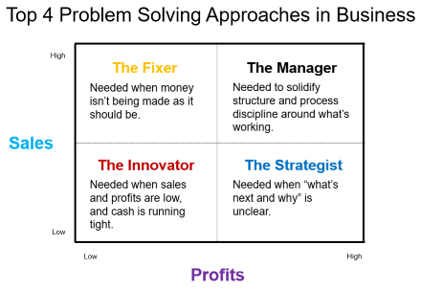
If you aren’t clear on where your business needs the most improvement, and you aren’t sure how best to approach the problems holding you back from higher profits and more consistent cash flow, you will never make the money you should.
The best problem solvers frequently take stock of where they’re currently at, what’s working well, and where they are getting stuck relative to where they’re headed. This is how they identify which is the best problem-solving approach to close the gap between where they are now and where they want to be tomorrow, next week, month, and year.
Overview
The Top Four Problem-Solving Approaches in business involve the skills of fixers, innovators, managers, and strategists. The most effective leaders use a combination of these four styles for solving problems, while the ineffective ones have a favored go-to mode they’re comfortable with. As a result, they over-rely on their preferred approach to problem-solving rather than flexing their problem-solving approaches as required to solve their most pressing problem.
At any one time in business there is always one “number one” problem to solve. What that #1 problem is most often depends on how well sales and profits are performing relative to each other. For example, high sales and low profits present different problems than low sales and high profits.
The first scenario indicates a conversion cost problem with a business overspending to generate sales, whereas the second scenario is unsustainable. Eventually, businesses with high profits and declining sales will fall into low profits and low sales unless things going forward are done differently to generate more new sales at higher profits.
Below are the four most common approaches to solving problems in business:
The Fixer—needed when money isn’t being made as it should be. Fixers are drawn to chaos. The most typical problems they solve involve high sales and low profits.
The Innovator—needed when sales and profits are low, and cash is running tight. Innovators look at where they are with a fresh perspective to reinvent how something has been done or to invent something from scratch. The most typical problem they solve is when things need to be done quickly differently to improve sales and profits.
The Manager—needed to solidify structure and process discipline around what’s working. Managers ensure the business fundamentals, process, and structure are in place to sustain their ability to make more money through ever increasing sales and profits. The most typical problem they solve is fine-tuning the actions that are working for continuous sales and profit improvement.
The Strategist—needed when “what’s next and why” is unclear. Strategists are skilled at seeing the big picture, the whole playing field, what’s coming around the corner, so they are ahead of potential sales problems that will lead to profit problems. Ideally, the strategist is working on what’s next while profits are high to stay ahead of problems needing solutions.
The best problem solvers frequently take stock of where they’re currently at, what’s working well, and where they are getting stuck relative to where they’re headed. This is how they identify which is the best problem-solving approach to close the gap between where they are now and where they want to be tomorrow, next week, month, and year.
